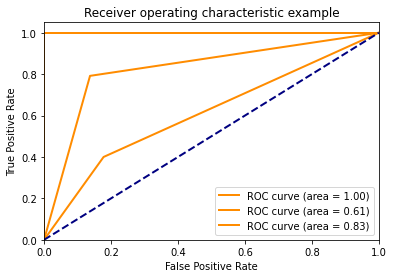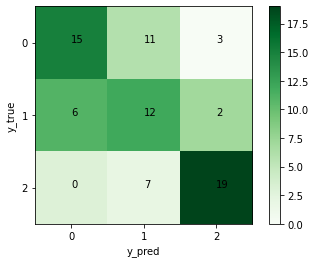python实现多分类评价指标
1、什么是多分类?
参考:https://www.jianshu.com/p/9332fcfbd197
针对多类问题的分类中,具体讲有两种,即multiclass classification和multilabel classification。multiclass是指分类任务中包含不止一个类别时,每条数据仅仅对应其中一个类别,不会对应多个类别。multilabel是指分类任务中不止一个分类时,每条数据可能对应不止一个类别标签,例如一条新闻,可以被划分到多个板块。
无论是multiclass,还是multilabel,做分类时都有两种策略,一个是one-vs-the-rest(one-vs-all),一个是one-vs-one。
在one-vs-all策略中,假设有n个类别,那么就会建立n个二项分类器,每个分类器针对其中一个类别和剩余类别进行分类。进行预测时,利用这n个二项分类器进行分类,得到数据属于当前类的概率,选择其中概率最大的一个类别作为最终的预测结果。
在one-vs-one策略中,同样假设有n个类别,则会针对两两类别建立二项分类器,得到k=n*(n-1)/2个分类器。对新数据进行分类时,依次使用这k个分类器进行分类,每次分类相当于一次投票,分类结果是哪个就相当于对哪个类投了一票。在使用全部k个分类器进行分类后,相当于进行了k次投票,选择得票最多的那个类作为最终分类结果。
2、构建多个二分类器进行分类
使用的数据集是sklearn自带的iris数据集,该数据集总共有三类。
import numpy as np import matplotlib.pyplot as plt from sklearn import svm,datasets from itertools import cycle from sklearn import svm, datasets from sklearn.metrics import roc_curve, auc from sklearn.model_selection import train_test_split from sklearn.preprocessing import label_binarize from sklearn.multiclass import OneVsRestClassifier from scipy import interp # 导入鸢尾花数据集 iris = datasets.load_iris() X = iris.data # X.shape==(150, 4) y = iris.target # y.shape==(150, ) # 二进制化输出 y = label_binarize(y, classes=[0, 1, 2]) # shape==(150, 3) n_classes = y.shape[1] # n_classes==3 #np.r_是按列连接两个矩阵,就是把两矩阵上下相加,要求列数相等。 #np.c_是按行连接两个矩阵,就是把两矩阵左右相加,要求行数相等。 # 添加噪音特征,使问题更困难 random_state = np.random.RandomState(0) n_samples, n_features = X.shape # n_samples==150, n_features==4 X = np.c_[X, random_state.randn(n_samples, 200 * n_features)] # shape==(150, 84)
# 打乱数据集并切分训练集和测试集 X_train, X_test, y_train, y_test = train_test_split(X, y, test_size=.5, random_state=0) # X_train.shape==(75, 804), X_test.shape==(75, 804), y_train.shape==(75, 3), y_test.shape==(75, 3) # 学习区分某个类与其他的类 classifier = OneVsRestClassifier(svm.SVC(kernel='linear', probability=True, random_state=random_state)) y_score = classifier.fit(X_train, y_train).decision_function(X_test)
这里提一下classifier.fit()后面接的函数:可以是decision_function()、predict_proba()、predict()
predict():返回预测标签、
predict_proba():返回预测属于某标签的概率
decision_function():返回样本到分隔超平面的有符号距离来度量预测结果的置信度
这里我们分别打印一下对应的y_score,只取前三条数据:
预测标签:[[0 0 1] [0 1 0] [1 0 0]...]
概率:[[6.96010030e-03 1.67062907e-01 9.65745632e-01] [4.57532814e-02 3.05231268e-01 4.58939259e-01] [7.00832624e-01 2.32537226e-01 4.92996070e-02]...]
距离:[[-1.18047012 -2.60334173 1.48134717] [-0.72354789 0.15798952 -0.08648247] [ 0.22439326 -1.15044791 -1.35488445]...]
同时,我们还要注意使用到了:OneVsRestClassifier,如何理解呢?
我们可以这么看:OneVsRestClassifier实际上包含了多个分类器,有多少个类别就有多少个分类器,这里有三个类别,因此就有三个分类器,可以通过:
print(classifier.estimators_)
来查看:
[SVC(C=1.0, break_ties=False, cache_size=200, class_weight=None, coef0=0.0, decision_function_shape='ovr', degree=3, gamma='scale', kernel='linear', max_iter=-1, probability=True, random_state=RandomState(MT19937) at 0x7F480F316A98, shrinking=True, tol=0.001, verbose=False), SVC(C=1.0, break_ties=False, cache_size=200, class_weight=None, coef0=0.0, decision_function_shape='ovr', degree=3, gamma='scale', kernel='linear', max_iter=-1, probability=True, random_state=RandomState(MT19937) at 0x7F480F316CA8, shrinking=True, tol=0.001, verbose=False), SVC(C=1.0, break_ties=False, cache_size=200, class_weight=None, coef0=0.0, decision_function_shape='ovr', degree=3, gamma='scale', kernel='linear', max_iter=-1, probability=True, random_state=RandomState(MT19937) at 0x7F480F316DB0, shrinking=True, tol=0.001, verbose=False)]
对于每一个分类器,都是二分类,即将当前的类视为一类,另外的其他类视为一类,比如说我们可以取得其中的分类器进行分类,以第一个标签为例:
y_true=np.where(y_test==1)[1]
array([2, 1, 0, 2, 0, 2, 0, 1, 1, 1, 2, 1, 1, 1, 1, 0, 1, 1, 0, 0, 2, 1, 0, 0, 2, 0, 0, 1, 1, 0, 2, 1, 0, 2, 2, 1, 0, 1, 1, 1, 2, 0, 2, 0, 0, 1, 2, 2, 2, 2, 1, 2, 1, 1, 2, 2, 2, 2, 1, 2, 1, 0, 2, 1, 1, 1, 1, 2, 0, 0, 2, 1, 0, 0, 1])
#这里重新定义标签,1代表当前标签,0代表其他标签 y0=[0 if i==0 else 1 for i in y_true] print(y0) print(classifier.estimators_[0].fit(X_train,y0).predict(X_test))
[0, 0, 1, 0, 1, 0, 1, 0, 0, 0, 0, 0, 0, 0, 0, 1, 0, 0, 1, 1, 0, 0, 1, 1, 0, 1, 1, 0, 0, 1, 0, 0, 1, 0, 0, 0, 1, 0, 0, 0, 0, 1, 0, 1, 1, 0, 0, 0, 0, 0, 0, 0, 0, 0, 0, 0, 0, 0, 0, 0, 0, 1, 0, 0, 0, 0, 0, 0, 1, 1, 0, 0, 1, 1, 0]
[0 0 1 1 1 0 0 0 0 0 0 0 0 0 0 0 0 0 0 0 0 1 0 0 1 0 0 0 0 0 1 0 1 0 0 0 0 0 0 0 1 1 0 1 1 1 1 0 0 0 0 0 0 1 0 1 0 1 0 1 0 0 0 1 0 1 0 1 0 0 1 0 1 0 0]
我们直接打印y_score中第0列的结果y_score[:,0]:
[0 0 1 0 1 0 1 0 0 0 0 0 0 0 0 1 0 0 1 1 0 0 1 1 0 1 1 0 0 1 0 0 1 0 0 0 1 0 0 0 0 1 0 1 1 0 0 0 0 0 0 0 0 0 0 0 0 0 0 0 0 1 0 0 0 0 0 0 1 1 0 0 1 1 0]
就是对应的第一个分类器的结果。(这里的结果不一致是因为classifier.estimators_[0].fit(X_train,y0).predict(X_test)相当于有重新训练并预测了一次。
从而,y_score中的每一列都表示了每一个分类器的结果。
所以,在y_score的结果中出现了:[1,1,0]这种就不足为怪了。但是有个问题,如果其中有两个分类器都将某个类认为是当前类,那么这类到底属于哪一个类呢?所以不能直接就对每一个分类器的概率值取得标签值,而是要计算出每一个分类器的概率值,最后再进行映射成标签。回过头来才发现的,以下使用的是predict(),因此是有问题的,但是基本方式是差不多的,再修改就有点麻烦了,酌情阅读了= =。
多分类问题就转换为了oneVsRest问题,可以分别使用二分类评价指标了,可参考:
https://www.cnblogs.com/xiximayou/p/13682052.html
比如说绘制ROC和计算AUC:
from sklearn.metrics import roc_curve, auc # 为每个类别计算ROC曲线和AUC fpr = dict() tpr = dict() roc_auc = dict() n_classes=3 for i in range(n_classes): fpr[i], tpr[i], _ = roc_curve(y_test[:, i], y_score[:, i]) roc_auc[i] = auc(fpr[i], tpr[i]) # fpr[0].shape==tpr[0].shape==(21, ), fpr[1].shape==tpr[1].shape==(35, ), fpr[2].shape==tpr[2].shape==(33, ) # roc_auc {0: 0.9118165784832452, 1: 0.6029629629629629, 2: 0.7859477124183007} plt.figure() lw = 2 for i in range(n_classes): plt.plot(fpr[i], tpr[i], color='darkorange', lw=lw, label='ROC curve (area = %0.2f)' % roc_auc[i]) plt.plot([0, 1], [0, 1], color='navy', lw=lw, linestyle='--') plt.xlim([0.0, 1.0]) plt.ylim([0.0, 1.05]) plt.xlabel('False Positive Rate') plt.ylabel('True Positive Rate') plt.title('Receiver operating characteristic example') plt.legend(loc="lower right") plt.show()

3、多分类评价指标?
宏平均 Macro-average
Macro F1:将n分类的评价拆成n个二分类的评价,计算每个二分类的F1 score,n个F1 score的平均值即为Macro F1。
微平均 Micro-average
Micro F1:将n分类的评价拆成n个二分类的评价,将n个二分类评价的TP、FP、TN、FN对应相加,计算评价准确率和召回率,由这2个准确率和召回率计算的F1 score即为Micro F1。
对于二分类问题:
TP=cnf_matrix[1][1] #预测为正的真实标签为正 FP=cnf_matrix[0][1] #预测为正的真实标签为负 FN=cnf_matrix[1][0] #预测为负的真实标签为正 TN=cnf_matrix[0][0] #预测为负的真实标签为负 accuracy=(TP+TN)/(TP+FP+FN+TN) precision=TP/(TP+FP) recall=TP/(TP+FN) f1score=2 * precision * recall/(precision + recall)
ROC曲线:
横坐标:假正率(False positive rate, FPR),预测为正但实际为负的样本占所有负例样本的比例;
FPR = FP / ( FP +TN)
纵坐标:真正率(True positive rate, TPR),这个其实就是召回率,预测为正且实际为正的样本占所有正例样本的比例。
TPR = TP / ( TP+ FN)
AUC:就是roc曲线和横坐标围城的面积。
对于上述的oneVsRest:
# 计算微平均ROC曲线和AUC fpr["micro"], tpr["micro"], _ = roc_curve(y_test.ravel(), y_score.ravel()) roc_auc["micro"] = auc(fpr["micro"], tpr["micro"]) # 计算宏平均ROC曲线和AUC # 首先汇总所有FPR all_fpr = np.unique(np.concatenate([fpr[i] for i in range(n_classes)])) # 然后再用这些点对ROC曲线进行插值 mean_tpr = np.zeros_like(all_fpr) for i in range(n_classes): mean_tpr += interp(all_fpr, fpr[i], tpr[i]) # 最后求平均并计算AUC mean_tpr /= n_classes fpr["macro"] = all_fpr tpr["macro"] = mean_tpr roc_auc["macro"] = auc(fpr["macro"], tpr["macro"]) # 绘制所有ROC曲线 plt.figure() lw = 2 plt.plot(fpr["micro"], tpr["micro"], label='micro-average ROC curve (area = {0:0.2f})' ''.format(roc_auc["micro"]), color='deeppink', linestyle=':', linewidth=4) plt.plot(fpr["macro"], tpr["macro"], label='macro-average ROC curve (area = {0:0.2f})' ''.format(roc_auc["macro"]), color='navy', linestyle=':', linewidth=4) colors = cycle(['aqua', 'darkorange', 'cornflowerblue']) for i, color in zip(range(n_classes), colors): plt.plot(fpr[i], tpr[i], color=color, lw=lw, label='ROC curve of class {0} (area = {1:0.2f})' ''.format(i, roc_auc[i])) plt.plot([0, 1], [0, 1], 'k--', lw=lw) plt.xlim([0.0, 1.0]) plt.ylim([0.0, 1.05]) plt.xlabel('False Positive Rate') plt.ylabel('True Positive Rate') plt.title('Some extension of Receiver operating characteristic to multi-class') plt.legend(loc="lower right") plt.show()

接下来我们将分类视为一个整体:
from sklearn.metrics import confusion_matrix classes=[0,1,2] y_my_test=np.where(y_test==1)[1] y_my_score=np.zeros(y_my_test.shape) for i in range(len(classes)): y_my_score[np.where(y_score[:,i]==1)]=i confusion = confusion_matrix(y_my_test, y_my_score)# 绘制热度图 plt.imshow(confusion, cmap=plt.cm.Greens) indices = range(len(confusion)) plt.xticks(indices, classes) plt.yticks(indices, classes) plt.colorbar() plt.xlabel('y_pred') plt.ylabel('y_true') # 显示数据 for first_index in range(len(confusion)): for second_index in range(len(confusion[first_index])): plt.text(first_index, second_index, confusion[first_index][second_index]) # 显示图片 plt.show()
我们首先要将测试标签和预测标签转换为非One-hot编码,才能计算出混淆矩阵:

计算出每一类的评价指标:
from sklearn.metrics import classification_report t = classification_report(y_my_test, y_my_score, target_names=['0', '1', '2'])
precision recall f1-score support 0 0.52 0.71 0.60 21 1 0.60 0.40 0.48 30 2 0.73 0.79 0.76 24 accuracy 0.61 75 macro avg 0.62 0.64 0.61 75 weighted avg 0.62 0.61 0.60 75
如果要使用上述的值,需要这么使用:
t = classification_report(y_my_test, y_my_score, target_names=['0', '1', '2'],output_dict=True)
{'0': {'precision': 0.5172413793103449, 'recall': 0.7142857142857143, 'f1-score': 0.6000000000000001, 'support': 21}, '1': {'precision': 0.6, 'recall': 0.4, 'f1-score': 0.48, 'support': 30}, '2': {'precision': 0.7307692307692307, 'recall': 0.7916666666666666, 'f1-score': 0.76, 'support': 24}, 'accuracy': 0.6133333333333333, 'macro avg': {'precision': 0.6160035366931919, 'recall': 0.6353174603174603, 'f1-score': 0.6133333333333334, 'support': 75}, 'weighted avg': {'precision': 0.6186737400530504, 'recall': 0.6133333333333333, 'f1-score': 0.6032000000000001, 'support': 75}}
我们可以分别计算每一类的相关指标:
import sklearn for i in range(len(classes)): precision=sklearn.metrics.precision_score(y_test[:,i], y_score[:,i], labels=None, pos_label=1, average='binary', sample_weight=None) print("{} precision:{}".format(i,precision))
也可以整体计算:
from sklearn.metrics import precision_score print(precision_score(y_test, y_score, average="micro"))
average可选参数micro、macro、weighted
具体的计算方式可以去参考:
https://zhuanlan.zhihu.com/p/59862986
参考:
https://blog.csdn.net/hfutdog/article/details/88079934



 浙公网安备 33010602011771号
浙公网安备 33010602011771号